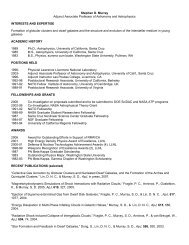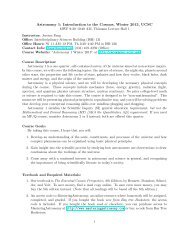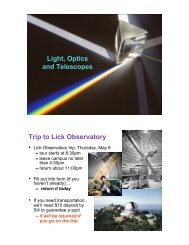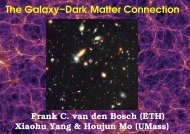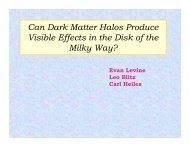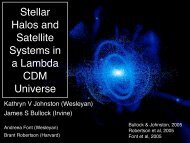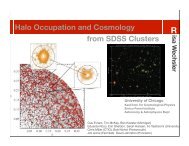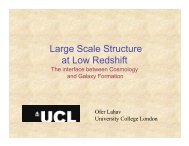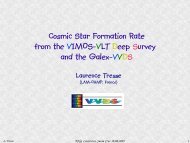What is different about LINER Galaxies
What is different about LINER Galaxies
What is different about LINER Galaxies
Create successful ePaper yourself
Turn your PDF publications into a flip-book with our unique Google optimized e-Paper software.
Sandy Faber has several First-Year Project ideas, some in connection with the<br />
DEEP survey, others in connection with Sloan data. All are related to galaxy<br />
formation, and all get you working with data and teach you useful tools. All of<br />
them are GUARANTEED to yield a publ<strong>is</strong>hed paper. Finally, all are a good<br />
introduction to future work on galaxy evolution, if that topic interests you.<br />
2) "<strong>What</strong> <strong>is</strong> <strong>different</strong> <strong>about</strong> <strong>LINER</strong> galaxies?"<br />
- A major question in galaxy evolution <strong>is</strong> what<br />
controls the star formation h<strong>is</strong>tories of galaxies.<br />
We observe that the "red sequence" (i.e., ellipticals<br />
and S0's) have very low star formation rates and<br />
stand apart from normal, blue, star-forming galaxies.<br />
Also that the number of RS galaxies <strong>is</strong> increasing<br />
with time, and hence that galaxies are "going out".<br />
Why? There are many theories, ranging from dark<br />
halo mass going over some critical threshold to<br />
feedback from star bursts to feedback from AGNs<br />
to the gas supply simply running out.<br />
- <strong>LINER</strong>S are enigmatic objects on the RS that<br />
exhibit weak em<strong>is</strong>sion. Th<strong>is</strong> does not come from<br />
H II regions but rather from heating by some very<br />
hot objects, perhaps (in part) AGNs. <strong>LINER</strong>S may<br />
represent some "dying-down" phase of AGN activity<br />
as galaxies go out. The location of <strong>LINER</strong>S in<br />
the color-mass diagram suggests that they may also be<br />
recently quenched RS galaxies.<br />
- Th<strong>is</strong> project would build on three previous<br />
First-Year Projects by UCSC students. The<br />
work of J Cheng, E Lopez, and J Graves produced<br />
a large database on Sloan RS galaxies, including<br />
structural properties, bulge-d<strong>is</strong>k ratios (i.e.,<br />
E vs S0 classifications), velocity d<strong>is</strong>persions, radii,<br />
stellar population ages and metallicities, and<br />
halo mass. These stuents found many results showing<br />
how the structural properties of RS galaxies vary<br />
with galaxy mass, sigma, radii, and environment. However,<br />
for simplicity the analys<strong>is</strong> to date has focussed<br />
on non-<strong>LINER</strong>, purely quiescent galaxies without either<br />
AGN or SFR activity. Th<strong>is</strong><br />
project would add <strong>LINER</strong>S to the data base to see<br />
if they exhibit <strong>different</strong> properties compared to
the many relationships already d<strong>is</strong>covered for<br />
the normals. Differences could reveal something<br />
<strong>about</strong> the life-h<strong>is</strong>tories of <strong>LINER</strong>S vs. quiescents,<br />
and also whether the ex<strong>is</strong>ting relationships for<br />
quiescents need substantial reworking for <strong>LINER</strong>S.<br />
- Skills needed: using the Sloan data base. Learning<br />
to use IDL to analyze data and make plots.<br />
General familiarity with early-type<br />
galaxy stellar populations AND AGN activity.<br />
Potentially, advanced stat<strong>is</strong>tical techniques needed<br />
to compare <strong>LINER</strong>S to non-<strong>LINER</strong>S



